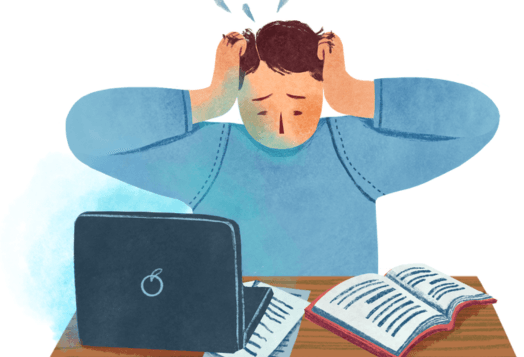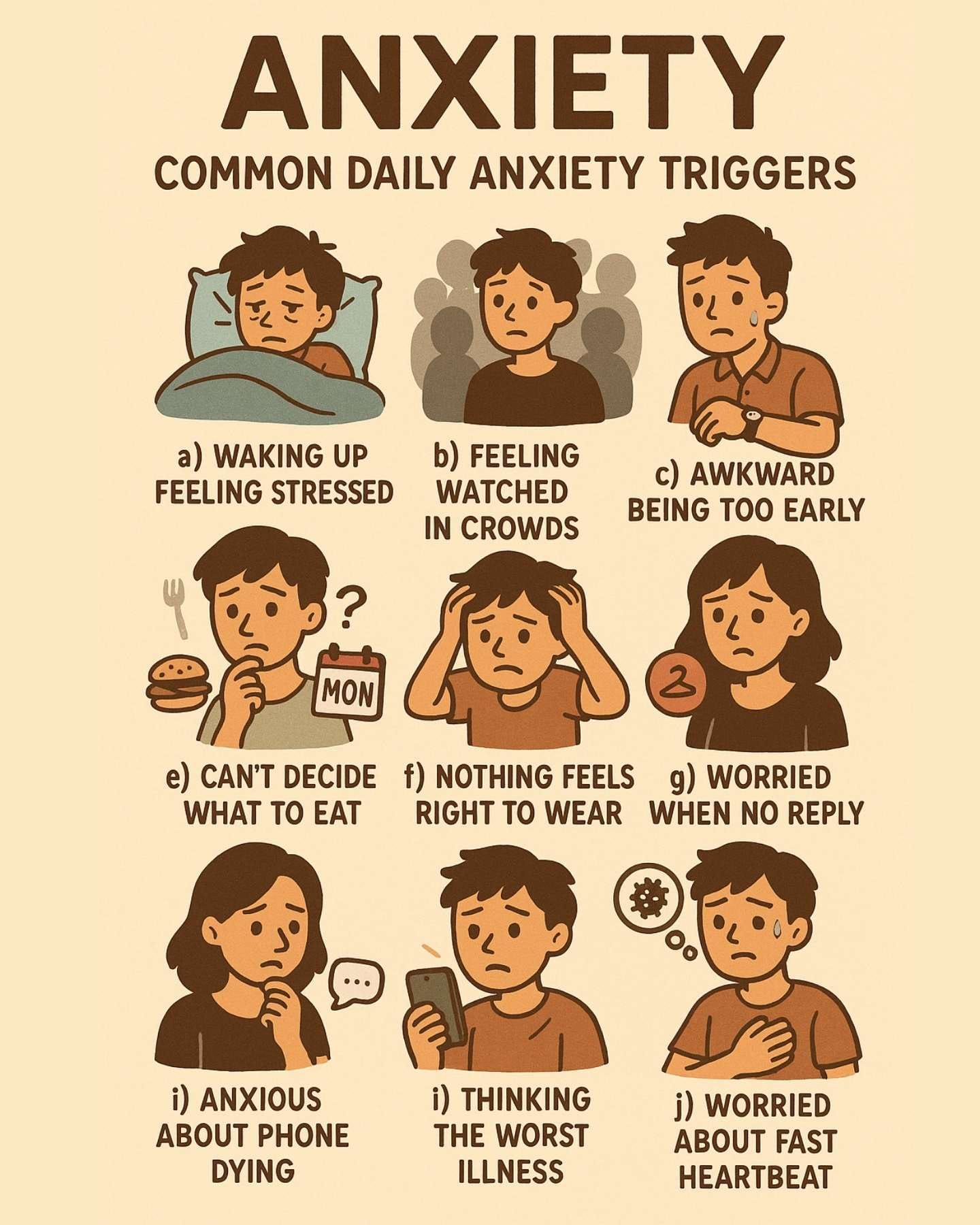
According to national prevalence data, anxiety disorders affect 40 million adults in the United States alone. But here's what those statistics don't capture: the daily moments where anxiety problems creep in, making simple tasks feel overwhelming. Let's talk about what anxiety really looks like in everyday life and, more importantly, how you can manage it effectively.
When Anxiety Shows Up in Your Daily Life (And Why It Happens)
Anxiety symptoms in adults aren't just about big, life-changing events. It's often the small, everyday situations that trigger our stress response. Scientists explain that our brains can't always distinguish between real threats and perceived ones, so our nervous system reacts the same way to a job interview as it would to encountering a dangerous animal. This is the emotional impact of anxiety in action.
Common Daily Anxiety Triggers:

Understanding Different Types of Anxiety
Let’s understand the types and choose the right way to cope with anxiety.
1. Generalised Anxiety Disorder (GAD):
This is the "what if" anxiety - your brain constantly jumps from one worry to another. You might find yourself catastrophising about everything from your health to your relationships to world events.
2. Social Anxiety Disorder:
More than just shyness, this involves intense fear of judgment or embarrassment in social situations. The amygdala (your brain's fear centre) becomes hyperactive in social contexts.
3. Panic Disorder:
Characterised by sudden, intense episodes of fear accompanied by physical symptoms like chest pain, shortness of breath, and dizziness. These panic attacks can happen anywhere, often without warning.
4. Health Anxiety (Hypochondriasis):
Excessive worry about having or developing serious illnesses, often triggered by normal bodily sensations or minor symptoms.
5. High-Functioning Anxiety:
You appear calm and successful on the outside, but internally, you're battling perfectionism, overthinking, and constant self-criticism, which may tie to impostor syndrome. This type often goes unrecognised because it doesn't fit the typical anxiety stereotype.
After covering the types and effects of anxiety on daily life, let’s move on to the strategies for overcoming anxiety in daily life.
Effective Strategies for Managing Daily Anxiety
Now let’s dive into practical, science-backed ways to cope with anxiety. These are not just concepts; they are tools to help with overcoming anxiety, whether you’re stuck at work, alone at night, or in a noisy crowd.
1. The STOP Technique (Immediate Anxiety Relief)
When you feel anxiety building, try this four-step process:
Stop what you're doing
Take a deep breath
Observe what you're feeling without judgment
Proceed with intention
Research at Yale shows that this simple technique can interrupt the anxiety spiral & help with managing anxiety in the daily routine.
2. Progressive Muscle Relaxation (PMR)
PMR works wonders for physical health conditions that trigger anxiety, like tight muscles and a racing heart. This technique, developed by Dr. Edmund Jacobson, involves tensing and then releasing different muscle groups. Start with your toes, tense them for 5 seconds, then release. Move up through your body - calves, thighs, abdomen, arms, shoulders, and face. This helps release physical tension that often accompanies anxiety.
3. The 3-3-3 Rule for Panic Moments
When anxiety spikes suddenly:
Name 3 things you can see
Name 3 sounds you can hear
Move 3 parts of your body (fingers, toes, shoulders)
This grounds you in the present moment and activates your parasympathetic nervous system.
4. Cognitive Restructuring (Changing Anxious Thoughts)
CBT (Cognitive Behavioural Therapy) technique, key to gaining control over your thoughts, is well known for anxiety. Research shows that our thoughts directly influence our feelings. When you notice anxious thoughts:
Identify the thought: "Everyone will think I'm stupid if I ask this question"
Examine the evidence: "Has this actually happened before? What would I tell a friend?"
Replace with a balanced thought: "Most people appreciate questions because it show engagement"
5. The Worry Window Technique
Great for overcoming anxiety at work or school. Set aside 15 minutes daily as your designated "worry time." When anxious thoughts arise outside this window, write them down and tell yourself you'll address them during worry time. This technique helps you have more mental space & energy to focus on other areas of life.
6. Breathing Techniques That Actually Work
Box Breathing: Inhale for 4, hold for 4, exhale for 4, hold for 4. Navy SEALs use this technique to stay calm under pressure.
4-7-8 Breathing: Inhale for 4, hold for 7, exhale for 8. Research shows this activates the relaxation response within minutes. It calms the nervous system and helps reduce anxiety naturally.
7. Movement as Medicine
You don't need intense workouts. A 10-minute walk can reduce anxiety symptoms for up to 12 hours, according to research. The key is consistency, not intensity.
8. Mindfulness Micro-Practices
Use the RAIN method for the emotional impact of anxiety:
Recognise what's happening
Allow the experience to be there
Investigate with kindness
Non-attachment - let the feeling pass
Even 2-3 minutes of mindfulness can lower cortisol levels and reduce anxiety symptoms.
Dealing with Specific Daily Anxiety Situations
1. How to Handle Social Anxiety as a Single Friend
Being the only single person in a group can trigger intense anxiety and feelings of inadequacy, often linked to loneliness. Here's how to navigate this:
Reframe Your Narrative: Instead of "I'm behind in life," try "I'm on my own timeline." Did you know that single people often have stronger friendships?
Prepare Conversation Starters: Have 2-3 topics ready that aren't relationship-focused - travel plans, new hobbies, work projects, or shared interests.
Create Your Own Joy: Plan something you genuinely enjoy before or after social events. This gives you something to look forward to and reminds you of your independence.
2. Managing Anxiety Without Medication
Many people prefer to manage anxiety through lifestyle changes. Here are evidence-based approaches:
Nutrition for Anxiety Relief:
Omega-3 fatty acids (found in fish and walnuts) reduce inflammation linked to anxiety
Magnesium-rich foods (dark chocolate, spinach, almonds) help regulate the nervous system
Limit caffeine and alcohol, which can worsen anxiety symptoms
Sleep Hygiene: Poor sleep increases anxiety by 30%, according to UC Berkeley research. Create a consistent bedtime routine and aim for 7-9 hours nightly.
Herbal Supplements: Studies show that chamomile, valerian root, and passionflower can reduce anxiety symptoms. Always consult a healthcare provider before starting supplements.
3. Workplace Anxiety Management
If you’re exploring how to reduce anxiety naturally, try:
The 5-Minute Reset: Between meetings, do a quick breathing exercise or step outside. This prevents anxiety from building throughout the day.
Email Anxiety: Set specific times to check email rather than constantly monitoring. The average person checks email 74 times per day, which maintains a constant state of alertness.
Presentation Nerves: Practice the "power pose" for 2 minutes before speaking. This helps reduce cortisol and increases confidence.
4. Health Anxiety and Medical Worries
Worried about symptoms? These tips help address the causes of anxiety disorder and stop spiralling:
Limit Dr. Google: Set boundaries around health-related internet searches. When you feel the urge to Google symptoms, wait 24 hours first.
The 24-Hour Rule: Most health anxiety is worse immediately after noticing a symptom. Give yourself a day before taking action unless it's truly urgent.
Reality Testing: Ask yourself, "What would I tell a friend experiencing this?" We're often more rational about others' health concerns than our own.
When to Seek Professional Help
Consider therapy if anxiety:
Interferes with daily activities
Affects your sleep or appetite
Causes you to avoid important life experiences
Feels overwhelming despite your best efforts
Therapies like Cognitive Behavioural Therapy (CBT) and Exposure Response Prevention (ERP) have high success rates for anxiety disorders.
Your Anxiety Action Plan
Remember, managing anxiety isn't about eliminating it completely - it's about developing the tools to handle it when it arises. Start with one or two techniques that resonate with you, practice them consistently, and gradually build your toolkit.
Anxiety might be part of your daily experience, but it doesn't have to control your life. With the right strategies, support from mental health therapists, and self-compassion, you can learn to navigate anxious moments with greater ease and confidence.
You're not broken, and you're not alone. You're human, dealing with very human experiences, and that's exactly where healing begins.
Disclaimer: This blog is for informational purposes only and does not replace professional medical or psychological advice. If you are experiencing persistent or severe anxiety symptoms, please consult a licensed mental health professional.




